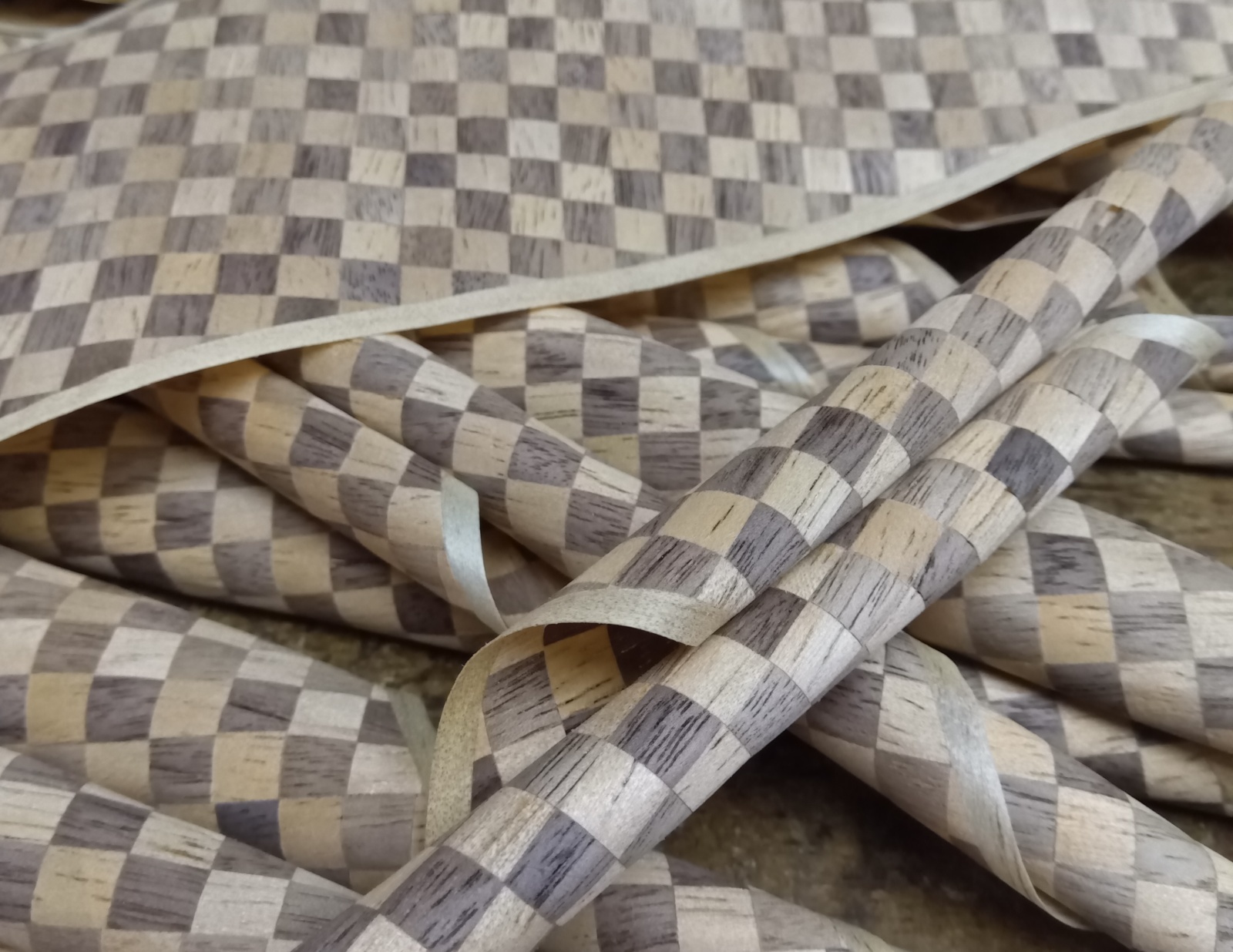The quality of the Ichimatsu-yosegi sheet

I had something to do this morning and went out, so I only did a little work in the afternoon. As I wrote in yesterday’s post, the ichimatsu yosegi for the 6-sun side panels, which I prepared a bit quickly, was completed safely and I sliced it today. But since slicing everything would take a long time, I sliced only the amount I needed for now. Because I’m making only a small number of 6-sun boxes this time, I sliced 36 pieces and attached them to the boards I had already prepared. As I mentioned earlier, there were a few small holes in the walnut parts, but they were within the range that I could repair, so it wasn’t a problem. However, the width of this ichimatsu yosegi turned out to be about 5 mm narrower than I originally expected. This kind of thing happens sometimes, but this time it was more than I planned. The sliced pieces look good, so I will use them as they are, but I will probably need to make the height of the 6-sun box a little lower.
Until now, I have made 6-sun boxes in slightly different sizes depending on various standards. For example, when I made boxes with wood inlay for Hakone Market, I adjusted the size to match the size of the inlay artwork. There isn’t one fixed standard for the side panels, so I have changed the size according to the design each time. But the overall size usually ends up being around 18 cm. Recently, the height of the boxes has been about 8 cm, but since I am making this one to match the ichimatsu yosegi, it will be a little lower—about 7.5 cm. I expected the finished yosegi sheet to be around 8 cm wide, but it ended up being 5–6 mm smaller than that. To be honest, I can freely change the size, but there is a balance between the length and the width. Since this is a 6-sun (18 cm) box, if the height is too low, it will look a little unbalanced. But I think that being 5–6 mm lower this time will not have much effect.
Following yesterday’s work, the photo shows the sheet after slicing. When I slice it without using water, it curls up like this. I use something like a warm iron to gently heat it and straighten it out. Because the heat dries it even more, the size becomes a little smaller. When I slice it with water, it doesn’t curl. Instead, the wood absorbs the moisture and expands, so it actually becomes slightly larger than before. Both methods have their advantages, but since I only make simple patterns like this, I use the method without water. Well, when I glue the sheet onto the panel, it stretches a little again because of the moisture in the glue.
While the glued panels are drying for a few days, I plan to prepare the top and bottom panels for the 6-sun box and continue making and preparing the materials for the other parts.
Until now, I have made 6-sun boxes in slightly different sizes depending on various standards. For example, when I made boxes with wood inlay for Hakone Market, I adjusted the size to match the size of the inlay artwork. There isn’t one fixed standard for the side panels, so I have changed the size according to the design each time. But the overall size usually ends up being around 18 cm. Recently, the height of the boxes has been about 8 cm, but since I am making this one to match the ichimatsu yosegi, it will be a little lower—about 7.5 cm. I expected the finished yosegi sheet to be around 8 cm wide, but it ended up being 5–6 mm smaller than that. To be honest, I can freely change the size, but there is a balance between the length and the width. Since this is a 6-sun (18 cm) box, if the height is too low, it will look a little unbalanced. But I think that being 5–6 mm lower this time will not have much effect.
Following yesterday’s work, the photo shows the sheet after slicing. When I slice it without using water, it curls up like this. I use something like a warm iron to gently heat it and straighten it out. Because the heat dries it even more, the size becomes a little smaller. When I slice it with water, it doesn’t curl. Instead, the wood absorbs the moisture and expands, so it actually becomes slightly larger than before. Both methods have their advantages, but since I only make simple patterns like this, I use the method without water. Well, when I glue the sheet onto the panel, it stretches a little again because of the moisture in the glue.
While the glued panels are drying for a few days, I plan to prepare the top and bottom panels for the 6-sun box and continue making and preparing the materials for the other parts.